From Wikipedia, the free encyclopedia
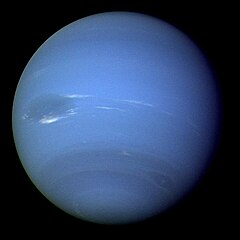 Neptune from Voyager 2 | |||||||||||||||||||||
| Discovery | |||||||||||||||||||||
|---|---|---|---|---|---|---|---|---|---|---|---|---|---|---|---|---|---|---|---|---|---|
| Discovered by: | Urbain Le Verrier John Couch Adams Johann Galle | ||||||||||||||||||||
| Discovery date: | 1846-09-23 [1] | ||||||||||||||||||||
| Orbital characteristics[2][3] | |||||||||||||||||||||
| Epoch J2000 | |||||||||||||||||||||
| Aphelion | 4,553,946,490 km 30.44125206 AU | ||||||||||||||||||||
| Perihelion: | 4,452,940,833 km 29.76607095 AU | ||||||||||||||||||||
| Semi-major axis: | 4,503,443,661 km 30.10366151 AU | ||||||||||||||||||||
| Eccentricity: | 0.011214269 | ||||||||||||||||||||
| Orbital period: | 60,190[4] days 164.79 yr | ||||||||||||||||||||
| Synodic period: | 367.49 day[5] | ||||||||||||||||||||
| Avg. orbital speed: | 5.43 km/s[5] | ||||||||||||||||||||
| Mean anomaly: | 267.767281° | ||||||||||||||||||||
| Inclination: | 1.767975° 6.43° to Sun's equator | ||||||||||||||||||||
| Longitude of ascending node: | 131.794310° | ||||||||||||||||||||
| Argument of perihelion: | 265.646853° | ||||||||||||||||||||
| Satellites: | 13 | ||||||||||||||||||||
| Physical characteristics | |||||||||||||||||||||
| Equatorial radius: | 24,764 ± 15 km[6][7] 3.883 Earths | ||||||||||||||||||||
| Polar radius: | 24,341 ± 30 km[6][7] 3.829 Earths | ||||||||||||||||||||
| Flattening: | 0.0171 ± 0.0013 | ||||||||||||||||||||
| Surface area: | 7.6408×109 km²[4][7] 14.94 Earths | ||||||||||||||||||||
| Volume: | 6.254×1013 km³[5][7] 57.74 Earths | ||||||||||||||||||||
| Mass: | 1.0243×1026 kg[5] 17.147 Earths | ||||||||||||||||||||
| Mean density: | 1.638 g/cm³[5][7] | ||||||||||||||||||||
| Equatorial surface gravity: | 11.15 m/s²[5][7] 1.14 g | ||||||||||||||||||||
| Escape velocity: | 23.5 km/s[5][7] | ||||||||||||||||||||
| Sidereal rotation period: | 0.6713 day[5] 16 h 6 min 36 s | ||||||||||||||||||||
| Rotation velocity at equator: | 2.68 km/s 9,660 km/h | ||||||||||||||||||||
| Axial tilt: | 28.32°[5] | ||||||||||||||||||||
| Right ascension of North pole: | 17 h 19 min 59 s 299.333°[6] | ||||||||||||||||||||
| Declination of North pole: | 42.950°[6] | ||||||||||||||||||||
| Albedo: | 0.290 (bond) 0.41 (geom.)[5] | ||||||||||||||||||||
| Surface temp.: 1 bar level 0.1 bar |
| ||||||||||||||||||||
| Apparent magnitude: | 8.0 to 7.78 [5] | ||||||||||||||||||||
| Angular size: | 2.2" — 2.4" [5] | ||||||||||||||||||||
| Adjectives: | Neptunian | ||||||||||||||||||||
| Atmosphere [5] | |||||||||||||||||||||
| Scale height: | 19.7 ± 0.6 km | ||||||||||||||||||||
| Composition: |
| ||||||||||||||||||||
- Note: This article contains special characters.
Neptune (pronounced /ˈnɛptjuːn/) is the eighth planet from the Sun in the Solar System. It is the fourth largest planet by diameter, and the third largest by mass. Neptune is 17 times the mass of Earth and is slightly more massive than its near-twin Uranus, which is 14 Earth masses and less dense. The planet is named after the Roman god of the sea. Its astronomical symbol is ![]() , a stylized version of Poseidon's Trident.
, a stylized version of Poseidon's Trident.
Neptune's atmosphere is primarily composed of hydrogen and helium along with traces of methane. The methane in the atmosphere, in part, accounts for the planet's blue appearance, but because Neptune's colour is much more vivid than that of Uranus, which has a similar amount of methane, another component is presumed to contribute to Neptune's intense colour.[8] Neptune also has the strongest winds of any planet in the solar system, measured as high as 2,100 km/h.[9] At the time of the 1989 Voyager 2 flyby, it had in its southern hemisphere a Great Dark Spot comparable to the Great Red Spot on Jupiter. Neptune's temperature at its cloud tops is usually close to −218 °C, one of the coldest in the solar system, due to its great distance from the sun. The temperature in Neptune's centre is about 7,000 °C, which is comparable to the Sun's surface and similar to most other known planets.
Discovered on September 23, 1846,[1] Neptune was the first planet discovered by mathematical prediction rather than regular observation. Perturbations in the orbit of Uranus led astronomers to deduce Neptune's existence. It has been visited by only one spacecraft, Voyager 2, which flew by the planet on August 25, 1989. In 2003, there was a proposal to NASA's "Vision Missions Studies" to implement a "Neptune Orbiter with Probes" mission that does Cassini-level science without fission-based electric power or propulsion. The work is being done in conjunction with JPL and the California Institute of Technology.[10]
Contents[hide] |
[edit] History
[edit] Discovery
Galileo's drawings show that he first observed Neptune on December 28, 1612, and again on January 27, 1613; on both occasions, Galileo mistook Neptune for a fixed star when it appeared very close (in conjunction) to Jupiter in the night sky.[11] Believing it to be a fixed star, he is not credited with its discovery. At the time of his first observation in December 1612, it was stationary in the sky because it had just turned retrograde that very day; because it was only beginning its yearly retrograde cycle, Neptune's motion was far too slight to be detected with Galileo's small telescope.[12]
In 1821, Alexis Bouvard published astronomical tables of the orbit of Uranus.[13] Subsequent observations revealed substantial deviations from the tables, leading Bouvard to hypothesize some perturbing body. In 1843, John Couch Adams calculated the orbit of an eighth planet that would account for Uranus' motion. He sent his calculations to Sir George Airy, the Astronomer Royal, who asked Adams for a clarification. Adams began to draft a reply but never sent it.

In 1846, Urbain Le Verrier, independently of Adams, produced his own calculations but also experienced difficulties in encouraging any enthusiasm in his compatriots. However, in the same year, John Herschel started to champion the mathematical approach and persuaded James Challis to search for the planet.
After much procrastination, Challis began his reluctant search in July 1846. However, in the meantime, Le Verrier had convinced Johann Gottfried Galle to search for the planet. Though still a student at the Berlin Observatory, Heinrich d'Arrest suggested that a recently drawn chart of the sky, in the region of Le Verrier's predicted location, could be compared with the current sky to seek the displacement characteristic of a planet, as opposed to a fixed star. Neptune was discovered that very night, September 23, 1846, within 1° of where Le Verrier had predicted it to be, and about 10° from Adams' prediction. Challis later realized that he had observed the planet twice in August, failing to identify it owing to his casual approach to the work.
In the wake of the discovery, there was much nationalistic rivalry between the French and the British over who had priority and deserved credit for the discovery. Eventually an international consensus emerged that both Le Verrier and Adams jointly deserved credit. However, the issue is now being re-evaluated by historians with the rediscovery in 1998 of the "Neptune papers" (historical documents from the Royal Greenwich Observatory), which had apparently been misappropriated by astronomer Olin Eggen for nearly three decades and were only rediscovered (in his possession) immediately after his death.[14] After reviewing the documents, some historians now suggest that Adams does not deserve equal credit with Le Verrier. [15]
[edit] Naming
Shortly after its discovery, Neptune was referred to simply as "the planet exterior to Uranus" or as "Le Verrier's planet". The first suggestion for a name came from Galle. He proposed the name Janus. In England, Challis put forth the name Oceanus. In France, Arago suggested that the new planet be called Leverrier, a suggestion which was met with stiff resistance outside France. French almanacs promptly reintroduced the name Herschel for Uranus and Leverrier for the new planet.
Meanwhile, on separate and independent occasions, Adams suggested altering the name Georgian to Uranus, while Le Verrier (through the Board of Longitude) suggested Neptune for the new planet. Struve came out in favor of that name on December 29, 1846, to the Saint Petersburg Academy of Sciences.[16] Soon Neptune became the internationally accepted nomenclature. In Roman mythology, Neptune was the god of the sea, identified with the Greek Poseidon. The demand for a mythological name seemed to be in keeping with the nomenclature of the other planets, all of which, except for Uranus, were named in antiquity.
The planet's name is translated literally as the sea king star in the Chinese,[17] Korean, Japanese, and Vietnamese languages (海王星 in Chinese characters, 해왕성 in Korean).
In India the name given to the planet is Varuna (Devanāgarī: वरुण), the god of the sea in Vedic/Hindu mythology, the equivalent of Poseidon/Neptune in the Greco-Roman mythology.
[edit] Structure
[edit] Mass and composition
With a mass of 1.0243×1026 kg,[5] Neptune is an intermediate body between Earth and the largest gas giants: it is seventeen Earth masses but just 1/18th the mass of Jupiter. It and Uranus are often considered a sub-class of gas giant termed "ice giants", given their smaller size and important differences in composition relative to Jupiter and Saturn. In the search for extra-solar planets Neptune has been used as a metonym: discovered bodies of similar mass are often referred to as "Neptunes".[18] just as astronomers refer to various extra-solar "Jupiters."
The atmosphere of Neptune is composed primarily of hydrogen, with a smaller proportion of helium. A trace amount of methane is also present. Prominent absorption bands of methane occur at wavelengths above 600 nm, in the red and infrared portion of the spectrum. This absorption of red light by the atmospheric methane gives Neptune its blue hue.[19]
Orbiting so far from the sun, Neptune receives very little heat with the uppermost regions of the atmosphere at −218 °C (55 K). Deeper inside the layers of gas, however, the temperature rises steadily. As with Uranus, the source of this heating is unknown, but the discrepancy is larger: Neptune is the farthest planet from the Sun, yet its internal energy is sufficient to drive the fastest planetary winds seen in the Solar System. Several possible explanations have been suggested, including radiogenic heating from the planet's core,[20] the continued radiation into space of leftover heat generated by infalling matter during the planet's birth,[citation needed] and gravity waves breaking above the tropopause.[21][22]
The internal structure resembles that of Uranus. The core is composed of rock and ice, and is likely no more than one Earth mass. The mantle is equivalent to 10 to 15 earth masses, rich in water, ammonia, methane, and other elements.[1] As is customary in planetary science, this mixture is referred to as an ice even though it is a hot and highly dense fluid. This fluid, which has a high electrical conductivity, is sometimes called a water–ammonia ocean.[23] The atmosphere, extending perhaps 10 to 20% of the way towards the center, is mostly hydrogen and helium at high altitudes (80% and 19%, respectively). Increasing concentrations of methane, ammonia, and water are found in the lower regions of the atmosphere. Gradually this darker and hotter area blends into the superheated liquid interior. The pressure at the center of Neptune is millions of times more than that on the surface of Earth. Comparing its rotational speed to its degree of oblateness indicates that it has its mass less concentrated towards the center than Uranus does.
[edit] Weather and magnetic field
One difference between Neptune and Uranus is the typical level of meteorological activity. When the Voyager spacecraft flew by Uranus in 1986 that planet was visually quite bland, while Neptune exhibited notable weather phenomena during its 1989 Voyager fly-by. Neptune's atmosphere has the highest wind speeds in the solar system, thought to be powered by the flow of internal heat, and its weather is characterized by extremely dynamic storm systems, with winds reaching up to around 2,100 km/h, near-supersonic speeds. Even more typical winds in the banded equatorial region can possess speeds of around 1,200 km/h.[24]
In 1989, the Great Dark Spot, a cyclonic storm system the size of Eurasia, was discovered by NASA's Voyager 2 spacecraft. The storm resembled the Great Red Spot of Jupiter. However, on November 2, 1994, the Hubble Space Telescope did not see the Great Dark Spot on the planet. Instead, a new storm similar to the Great Dark Spot was found in the planet's northern hemisphere. The reason for the Great Dark Spot's disappearance is unknown. One possible theory is that heat transfer from the planet's core disrupted the atmospheric equilibrium and disrupted existing circulation patterns.[citation needed] The Scooter is another storm, a white cloud group further south than the Great Dark Spot. Its nickname was bestowed when it was first detected in the months leading up to the Voyager encounter in 1989: it moved faster than the Great Dark Spot. Subsequent images showed clouds that moved even faster than Scooter. The Small Dark Spot is a southern cyclonic storm, the second most intensive storm during the 1989 encounter. It initially was completely dark, but as Voyager approached the planet, a bright core developed and is seen in most of the highest resolution images. In 2007 it was discovered that Neptune's south pole was about 10 °C warmer than the rest of Neptune which averages approximately −200 °C. The warmth differential is enough to let methane gas, which elsewhere lies frozen in Neptune's upper atmosphere, to leak out through the south pole and into space. The relative "hot spot" is due to Neptune's tilt in its orbit which has exposed the south pole to the Sun for the last 40 years, a Neptunian year being 165 Earth years. As Neptune slowly moves towards the sun, the south pole will be darkened and the north pole illuminated, causing the methane release to shift to the north pole. [25]
Unique among the gas giants is the presence of high clouds casting shadows on the opaque cloud deck below. Though Neptune's atmosphere is much more dynamic than that of Uranus, both planets are made of the same gases and ices. Uranus and Neptune are not strictly gas giants similar to Jupiter and Saturn, but are rather ice giants, meaning they have a larger solid core and are also made of ices. Neptune is very cold, with temperatures as low as −224 °C (49 K) recorded at the cloud tops in 1989.
Neptune also resembles Uranus in its magnetosphere, with a magnetic field strongly tilted relative to its rotational axis at 47° and offset at least 0.55 radii (about 13,500 kilometres) from the planet's physical centre. Comparing the magnetic fields of the two planets, scientists think the extreme orientation may be characteristic of flows in the interior of the planet and not the result of Uranus' sideways orientation.
[edit] Moons
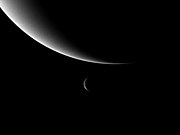
Neptune has 13 known moons.[5] The largest by far, and the only one massive enough to be spheroidal, is Triton, discovered by William Lassell just 17 days after the discovery of Neptune itself. Unlike all other large planetary moons, Triton has a retrograde orbit, indicating that it was captured, and probably was once a Kuiper Belt object. It is close enough to Neptune to be locked into a synchronous orbit, and is slowly spiraling inward and eventually will be torn apart when it reaches the Roche limit. Triton is the coldest object that has been measured in the solar system, with temperatures of −235 °C (38 K).
| Triton, compared to Earth's Moon | |||||
|---|---|---|---|---|---|
| Name | Diameter (km) | Mass (kg) | Orbital radius (km) | Orbital period (days) | |
| Triton | ˈtraɪtən | 2700 (80% Luna) | 2.15×1022 (30% Luna) | 354,800 (90% Luna) | -5.877 (20% Luna) |

Neptune's second known satellite (by order of distance), the irregular moon Nereid, has one of the most eccentric orbits of any satellite in the solar system.
From July to September 1989, Voyager 2 discovered six new Neptunian moons. Of these, the irregularly shaped Proteus is notable for being as large as a body of its density can be without being pulled into a spherical shape by its own gravity. Although the second most massive Neptunian moon, it is only one quarter of one percent of the mass of Triton. Neptune's innermost four moons, Naiad, Thalassa, Despina, and Galatea, orbit close enough to be within Neptune's rings. The next farthest out, Larissa was originally discovered in 1981 when it had occulted a star. This had been attributed to ring arcs, but when Voyager 2 observed Neptune in 1989, it was found to have been caused by the moon. Five new irregular moons discovered between 2002 and 2003 were announced in 2004.[26][27] As Neptune was the Roman god of the sea, the planet's moons have been named after lesser sea gods.
- For a timeline of discovery dates, see Timeline of discovery of Solar System planets and their natural satellites
[edit] Planetary rings
Faint azure coloured rings have been detected around the blue planet, but are much less substantial than those of Saturn. When these rings were discovered by a team led by Edward Guinan, it was thought that they might not be complete. However, this was disproved by Voyager 2.
These planetary rings have a peculiar "clumpy" structure,[28] the cause of which is not currently understood but which may be due to the gravitational interaction with small moons in orbit near them.[citation needed]
Evidence that the rings are incomplete first arose in the mid-1980s, when stellar occultation were found to occasionally show an extra "blink" just before or after the planet occulted the star. Images by Voyager 2 in 1989 settled the issue, when the ring system was found to contain several faint rings. The outermost ring, Adams, contains three prominent arcs now named Liberté, Egalité, and Fraternité (Liberty, Equality, and Fraternity). The existence of arcs is very difficult to understand because the laws of motion would predict that arcs spread out into a uniform ring over very short timescales. The gravitational effects of Galatea, a moon just inward from the ring, are now believed to confine the arcs.
Several other rings were detected by the Voyager cameras. In addition to the narrow Adams Ring 63,000 km from the centre of Neptune, the Leverrier Ring is at 53,000 km and the broader, fainter Galle Ring is at 42,000 km. A faint outward extension to the Leverrier Ring has been named Lassell; it is bounded at its outer edge by the Arago Ring at 57,000 km.[29]
New Earth-based observations announced in 2005 appeared to show that Neptune's rings are much more unstable than previously thought. Images taken from the W. M. Keck Observatory in 2002 and 2003 show considerable decay in the rings when compared to images by Voyager 2. In particular, it seems that the Liberté ring might disappear in as little as one century.[30]
[edit] Observation
Neptune is never visible to the naked eye, having a brightness between magnitudes +7.7 and +8.0, which can be outshone by Jupiter's Galilean moons, the dwarf planet Ceres and the asteroids 4 Vesta, 2 Pallas, 7 Iris, 3 Juno and 6 Hebe. A telescope or strong binoculars will resolve Neptune as a small blue disk, similar in appearance to Uranus; the blue colour comes from the methane in its atmosphere.[31] Its small apparent size has made it challenging to study visually; most telescopic data was fairly limited until the advent of Hubble Space Telescope and large ground-based telescopes with adaptive optics.
With a mean orbital period (sidereal period) of 164.79 Julian years, Neptune will return to its original heliocentric point of discovery on July 12, 2011.[32] It will not appear at its exact discovery position in our sky due to the Earth being in a different location in its 365.25 day orbit.
In astrology, Neptune will soon return to the approximate position in the sky where it was discovered in 1846. This will happen three different times, along with a fourth in which it will come very close to being at that position. These are April 11, 2009, when it will be in prograde motion; July 17, 2009, when it will be in retrograde motion; and February 7, 2010, when it will be in prograde motion. It will also come very close to being at the point of discovery in late October through early-mid November 2010, when Neptune will switch from retrograde to direct motion on the exact degree of Neptune's discovery and will then be stationary along the ecliptic within 2 arc minutes at that point (closest on November 7, 2010). This is explained by the concept of retrogradation. Like all planets beyond Earth, Neptune undergoes retrogradation at certain points during its synodic period. In addition to the start of retrogradation, other events within the synodic period include astronomical opposition, the return to prograde motion, and conjunction to the Sun.
[edit] Exploration
The closest approach of Voyager 2 to Neptune occurred on August 25, 1989. Since this was the last major planet the spacecraft could visit, it was decided to make a close flyby of the moon Triton, regardless of the consequences to the trajectory, similarly to what was done for Voyager 1's encounter with Saturn and its moon Titan.
The probe also discovered the Great Dark Spot, which has since disappeared, according to Hubble Space Telescope observations. Originally thought to be a large cloud itself, it was later postulated to be a hole in the visible cloud deck.
Neptune turned out to have the strongest winds of all the solar system's gas giants. In the outer regions of the solar system, where the Sun shines over 1000 times fainter than on Earth (still very bright with a magnitude of -21), the last of the four giants defied all expectations of the scientists.
One might expect that the farther one gets from the Sun, the less energy there would be to drive the winds around. The winds on Jupiter were already hundreds of kilometres per hour. Rather than seeing slower winds, the scientists found faster winds (over 1600 km/h) on more distant Neptune.
One suggested cause for this apparent anomaly is that if enough energy is produced, turbulence is created, which slows the winds down (like those of Jupiter). At Neptune however, there is so little solar energy that once winds are started they meet very little resistance, and are able to maintain extremely high velocities.[citation needed] Nonetheless, Neptune radiates more energy than it receives from the Sun,[33] and the internal energy source of these winds remains undetermined.
The images relayed back to Earth from Voyager 2 in 1989 became the basis of a PBS all-night program called Neptune All Night.[34]
[edit] See also
- Planets in astrology – Neptune
- Neptune in fiction
- Neptune Orbiter – Proposed space probe to Neptune to be launched after 2030.
- Neptune Trojans – Asteroids orbiting in Neptune's Lagrangian points.
- Neptune in music – One of the seven movements in Gustav Holst's orchestral suite, The Planets.
[edit] Notes
- ^ a b c Hamilton, Calvin J. (2001-08-04). Neptune. Views of the Solar System. Retrieved on 2007-08-13.
- ^ Yeomans, Donald K. (2006-07-13). HORIZONS System. NASA JPL. Retrieved on 2007-08-08. — At the site, go to the "web interface" then select "Ephemeris Type: ELEMENTS", "Target Body: Neptune Barycenter" and "Center: Sun".
- ^ Orbital elements refer to the barycenter of the Neptune system, and are the instantaneous osculating values at the precise J2000 epoch. Barycenter quantities are given because, in contrast to the planetary centre, they do not experience appreciable changes on a day-to-day basis from to the motion of the moons.
- ^ a b Neptune: Facts & Figures. NASA (06.05.07). Retrieved on 2007-08-14.
- ^ a b c d e f g h i j k l m n o p q Williams, Dr. David R. (September 01, 2004). Neptune Fact Sheet. NASA. Retrieved on 2007-08-14.
- ^ a b c d Seidelmann, P. Kenneth; Archinal, B. A.; A’hearn, M. F.; et.al. (2007). "Report of the IAU/IAGWorking Group on cartographic coordinates and rotational elements: 2006". Celestial Mech. Dyn. Astr. 90: 155–180. doi:10.1007/s10569-007-9072-y.
- ^ a b c d e f g Refers to the level of 1 bar atmospheric pressure
- ^ "Neptune overview," Solar System Exploration, NASA.
- ^ Suomi, V. E.; Limaye, S. S.; Johnson, D. R. (1991). "High winds of Neptune - A possible mechanism". Science 251: 929–932.
- ^ T. R. Spilker and A. P. Ingersoll (November 9, 2004). Outstanding Science in the Neptune System From an Aerocaptured Vision Mission. 36th DPS Meeting, Session 14 Future Missions.
- ^ Hirschfeld, Alan (2001). Parallax:The Race to Measure the Cosmos. New York, New York: Henry Holt. ISBN 0-8050-7133-4.
- ^ Littmann, Mark; Standish, E.M. (2004). Planets Beyond: Discovering the Outer Solar System. Courier Dover Publications. ISBN 0-4864-3602-0.
- ^ A. Bouvard (1821), Tables astronomiques publiées par le Bureau des Longitudes de France, Paris, FR: Bachelier
- ^ Kollerstrom, Nick (2001). Neptune's Discovery. The British Case for Co-Prediction.. Unuiversity College London. Archived from the original on 2005-11-11. Retrieved on 2007-03-19.
- ^ DIO 9.1 (June 1999); William Sheehan, Nicholas Kollerstrom, Craig B. Waff (December 2004). The Case of the Pilfered Planet - Did the British steal Neptune? Scientific American.
- ^ Hind, J. R. (1847). "Second report of proceedings in the Cambridge Observatory relating to the new Planet (Neptune)". Astronomische Nachrichten 25: 309. Smithsonian/NASA Astrophysics Data System (ADS).
- ^ Using Eyepiece & Photographic Nebular Filters, Part 2 (October 1997). Hamilton Amateur Astronomers at amateurastronomy.org.
- ^ "Trio of Neptunes", Astrobiology Magazine, May 21, 2006. Retrieved on 2007-08-06.
- ^ Crisp, D.; Hammel, H. B. (June 14, 1995). Hubble Space Telescope Observations of Neptune. Hubble News Center. Retrieved on 2007-04-22.
- ^ Williams, Sam (2004). "Heat Sources Within the Giant Planets" (DOC). Retrieved on 2007-10-10.
- ^ McHugh, J. P., Computation of Gravity Waves near the Tropopause, AAS/Division for Planetary Sciences Meeting Abstracts, p. 53.07, September, 1999
- ^ McHugh, J. P. and Friedson, A. J., Neptune's Energy Crisis: Gravity Wave Heating of the Stratosphere of Neptune, Bulletin of the American Astronomical Society, p.1078, September, 1996
- ^ Atreya, S.; Egeler, P.; Baines, K. (2006). "Water-ammonia ionic ocean on Uranus and Neptune?" (pdf). Geophysical Research Abstracts 8: 05179.
- ^ Hammel, H.B. et al. (1989). "Neptune's wind speeds obtained by tracking clouds in Voyager images". Science 245: 1367–1369.
- ^ "Neptune has a 'warm' south pole, astronomers find", Yahoo! News, September 19, 2007. Retrieved on 2007-09-20.
- ^ Holman, Matthew J. et al. (August 19, 2004). "Discovery of five irregular moons of Neptune". Nature 430: 865–867.
- ^ "Five new moons for planet Neptune", BBC News, August 18, 2004. Retrieved on 2007-08-06.
- ^ Missions to Neptune. The Planetary Society (2007). Retrieved on 2007-10-11.
- ^ Gazetteer of Planetary Nomenclature Ring and Ring Gap Nomenclature (December 8, 2004). USGS - Astrogeology Research Program.
- ^ Neptune's rings are fading away. New Scientist (March 26, 2005). Retrieved on 2007-08-06.
- ^ Moore, Patrick (2000). The Data Book of Astronomy, 207.
- ^ Horizons Output for Neptune 2010-2011. Retrieved on 2007-11-14.
- ^ Beebe R. (1992). "The clouds and winds of Neptune". Planetary Report 12: 18–21.
- ^ Fascination with Distant Worlds. SETI Institute. Retrieved on 2007-10-03.
[edit] References
- Adams, J. C. (November 13, 1846). "Explanation of the observed irregularities in the motion of Uranus, on the hypothesis of disturbance by a more distant planet". Monthly Notices of the Royal Astronomical Society 7: 149.
- Airy, G. B. (November 13, 1846). "Account of some circumstances historically connected with the discovery of the planet exterior to Uranus". Monthly Notices of the Royal Astronomical Society 7: 121–144.
- Challis, J., Rev. (November 13, 1846). "Account of observations at the Cambridge observatory for detecting the planet exterior to Uranus". Monthly Notices of the Royal Astronomical Society 7: 145–149.
- Galle (November 13, 1846). "Account of the discovery of the planet of Le Verrier at Berlin". Monthly Notices of the Royal Astronomical Society 7: 153.
- Dale P. Cruikshank (1995). Neptune and Triton. ISBN 0-8165-1525-5.
- Lunine J. I. (1993). "The Atmospheres of Uranus and Neptune". Annual Review of Astronomy and Astrophysics 31: 217–263. doi:10.1146/annurev.aa.31.090193.001245.
- Ellis D. Miner et Randii R. Wessen (2002). Neptune: The Planet, Rings, and Satellites. Springer-Verlag. ISBN 1-85233-216-6.
- Moore, Patrick (2000). The Data Book of Astronomy. CRC Press. ISBN 0-7503-0620-3.
- Smith, Bradford A. "Neptune." World Book Online Reference Center. 2004. World Book, Inc. (NASA.gov)
- Sheppard, Scott S.; Trujillo, Chadwick A. (June 2006). "A Thick Cloud of Neptune Trojans and Their Colors". Science 313 (5786): 511–514. doi:10.1126/science.1127173.
[edit] External links
| Find more information on Neptune by searching Wikipedia's sister projects | |
|---|---|
| Dictionary definitions from Wiktionary | |
| Textbooks from Wikibooks | |
| Quotations from Wikiquote | |
| Source texts from Wikisource | |
| Images and media from Commons | |
| News stories from Wikinews | |
| Learning resources from Wikiversity | |
- NASA's Neptune fact sheet
- Neptune Profile by NASA's Solar System Exploration
- MPC's List Of Neptune Trojans
- Planets - Neptune A kid's guide to Neptune.
- Neptune and global warming
Future missions to Neptune
- Popular Science article
- Universe Today
- Scientific American Magazine (December 2004 Issue) The Case of the Pilfered Planet
| [hide] | ||
|---|---|---|
| Moons | Naiad · Thalassa · Despina · Galatea · Larissa · Proteus · Triton · Nereid · Halimede · Sao · Laomedeia · Psamathe · Neso | 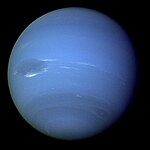 |
| Characteristics | Rings of Neptune · Great Dark Spot | |
| Discovery | John Couch Adams · Johann Gottfried Galle · William Lassell · Urbain Le Verrier | |
| Exploration | Voyager program · Voyager 2 | |
| Neptune Trojans | 2001 QR322 · 2004 UP10 · 2005 TN53 · 2005 TO74 · 2006 RJ103 | |
| Other | Neptune-crosser asteroid · Neptune in fiction | |
| [hide] The Solar System |
|---|
| |
| The Sun · Mercury · Venus · Earth · Mars · Ceres · Jupiter · Saturn · Uranus · Neptune · Pluto · Eris |
| Planets · Dwarf planets · Moons: Terrestrial · Martian · Jovian · Saturnian · Uranian · Neptunian · Plutonian · Eridian |
| Small bodies: Meteoroids · Asteroids/Asteroid moons (Asteroid belt) · Centaurs · TNOs (Kuiper belt/Scattered disc) · Comets (Oort cloud) |
| See also astronomical objects, the solar system's list of objects, sorted by radius or mass, and the Solar System Portal |
| Neptune Statistics | |
|---|---|
| Discovered by | Johann Gotfried Galle |
| Date of discovery | September 23, 1846 |
| Mass (kg) | 1.024e+26 |
| Mass (Earth = 1) | 1.7135e+01 |
| Equatorial radius (km) | 24,746 |
| Equatorial radius (Earth = 1) | 3.8799e+00 |
| Mean density (gm/cm^3) | 1.64 |
| Mean distance from the Sun (km) | 4,504,300,000 |
| Mean distance from the Sun (Earth = 1) | 30.0611 |
| Rotational period (hours) | 16.11 |
| Orbital period (years) | 164.79 |
| Mean orbital velocity (km/sec) | 5.45 |
| Orbital eccentricity | 0.0097 |
| Tilt of axis (degrees) | 29.56 |
| Orbital inclination (degrees) | 1.774 |
| Equatorial surface gravity (m/sec^2) | 11.0 |
| Equatorial escape velocity (km/sec) | 23.50 |
| Visual geometric albedo | 0.41 |
| Magnitude (Vo) | 7.84 |
| Mean cloud temperature | -193 to -153°C |
| Atmospheric pressure (bars) | 1-3 |
| Atmospheric composition Hydrogen Helium Methane | 85% 13% 2% |
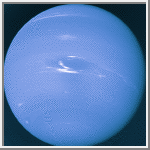 Neptune
Neptune
This picture of Neptune was taken by Voyager 2 on August 20, 1989. One of the great cloud features, dubbed the Great Dark Spot by Voyager scientists, can be seen toward the center of the image. It is at a latitude of 22 degrees south and circuits Neptune every 18.3 hours. The bright clouds to the south and east of the Great Dark Spot constantly change their appearances in periods as short as four hours. (Copyright Calvin J. Hamilton)
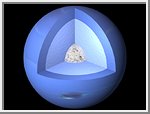 The Interior of Neptune
The Interior of Neptune
Our knowledge of the internal structure of Neptune is inferred from the planet's radius, mass, period of rotation, the shape of its gravitational field and the behavior of hydrogen, helium, and water at high pressure. This cut-away view shows Neptune composed of an outer envelope of molecular hydrogen, helium and methane roughly the mass of one to two Earths. Below this region Neptune appears to be composed of a mantle rich in water, methane, ammonia, and other elements. These elements are under high temperatures and pressures deep within the planet. The mantle is equivalent to 10 to 15 earth masses. Neptune's core is composed of rock and ice, and is likely no more than one Earth mass. (Copyright Calvin J. Hamilton)
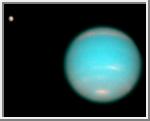 HST Observes Triton and Neptune
HST Observes Triton and Neptune
This mosaic combines an almost true-color picture of Neptune taken by the Hubble Space Telescope's (HST) Wide Field Planetary Camera (WFPC), with a picture of Triton taken with the HST's Faint Object Camera. Although faint, the image of Triton vaguely shows a brighter equatorial region. The south pole is to the lower left.
The picture of Neptune shows a bright cloud feature at the south pole, near the bottom of the image. Bright cloud bands can be seen at 30S and 60S latitude. The northern hemisphere also includes a bright cloud band centered near 30� N latitude. (Courtesy of Ted Stryk)
 HST Observations of Neptune
HST Observations of Neptune
These almost true-color pictures of Neptune were constructed from HST/WFPC2 images taken in blue (467-nm), green (588-nm), and red (673-nm) spectral filters. There is a bright cloud feature at the south pole, near the bottom right of the image. Bright cloud bands can be seen at 30S and 60S latitude. The northern hemisphere also includes a bright cloud band centered near 30° N latitude. The second picture was compiled from images taken after the planet had rotated about 180 degrees of longitude (about 9 hours later) to show the opposite hemisphere.
One feature that is conspicuous by its absence is the storm system known as the Great Dark Spot. The second smaller dark spot, DS2, that was seen during the Voyager-2 encounter was also missing. The absence of these dark spots was one of the biggest surprises of this program. These dramatic changes in the large-scale storm systems and planet-encircling clouds bands on Neptune are not yet completely understood, but they emphasize the dynamic nature of this planet's atmosphere, and the need for further monitoring.
 HST Observes High Altitude Clouds
HST Observes High Altitude Clouds
These three images were taken on October 10, October 18 and November 2, 1994, when Neptune was 4.5 billion kilometers from Earth. Building on Voyager's initial discoveries, Hubble has revealed that Neptune has a remarkably dynamic atmosphere that changes over just a few days. The temperature difference between Neptune's strong internal heat source and its frigid cloud tops (-162° Celcius or -260° Fahrenheit) might trigger instabilities in the atmosphere that drive these large-scale weather changes. The pink features are high-altitude methane ice crystal clouds.
 HST Finds New Dark Spot
HST Finds New Dark Spot
In June 1994, the Hubble telescope revealed that the Great Dark Spot found by Voyager 2 was missing. This new image taken on November 2, shows that a new spot near the limb of the planet has formed. Like its predecessor, the new spot has high altitude clouds along its edge, caused by gasses that have been pushed to higher altitudes where they cool to form methane ice crystal clouds. The dark spot may be a zone of clear gas that is a window to a cloud deck lower in the atmosphere.
 Cirrus-like Clouds
Cirrus-like Clouds
This image shows bands of sunlit cirrus-like clouds in Neptune's northern hemisphere. These clouds cast shadows on the blue cloud deck 35 miles below. The white streaky clouds are from 48 to 160 kilometers (30 to 100 miles) wide and extend for thousands of miles. (Copyright Calvin J. Hamilton)
 True-color Image
True-color Image
This Voyager 2 image has been processed by computers so that both the clouds' structure in the dark regions near the pole and the bright clouds east of the Great Dark Spot are visible. Small trails of clouds trending east to west and large-scale structure east of the Great Dark Spot all suggest that waves are present in the atmosphere and play a large role in the type of clouds that are visible. (Courtesy NASA/JPL)
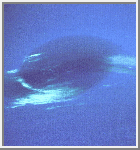 Great Dark Spot
Great Dark Spot
Feathery white clouds fill the boundary between the dark and light blue regions on the Great Dark Spot. The pinwheel shape of both the dark boundary and the white cirrus suggests that the storm system rotates counterclockwise. Periodic small scale patterns in the white cloud, possibly waves, are short lived and do not persist from one Neptunian rotation to the next. (Courtesy NASA/JPL)
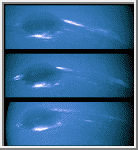 Change In The Great Dark Spot
Change In The Great Dark Spot
The bright cirrus-like clouds of Neptune change rapidly, often forming and dissipating over periods of several to tens of hours. In this sequence spanning two rotations of Neptune (about 36 hours) Voyager 2 observed cloud evolution in the region around the Great Dark Spot at an effective resolution of about 100 kilometers (62 miles) per pixel. The surprisingly rapid changes which occur over the 18 hours separating each panel shows that in this region Neptune's weather is perhaps as dynamic and variable as that of the Earth. However, the scale is immense by our standards. The Earth and the Great Dark Spot are of similar size and in Neptune's frigid atmosphere, where temperatures are as low as 55 degrees Kelvin (-360 F), the cirrus clouds are composed of frozen methane rather than Earth's crystals of water ice. (Courtesy NASA/JPL)
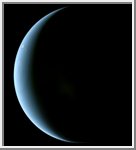 High Resolution Crescent Image of Neptune
High Resolution Crescent Image of Neptune
This high resolution crescent image of Neptune was taken by the Voyager 2 spacecraft on on August 31, 1989. A circular storm pattern can be seen on the limb of the planet. (Copyright 2001 by Calvin J. Hamilton)
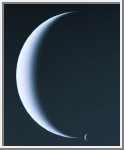 Parting Look
Parting Look
This Voyager 2 image shows a beautiful dual-crescent view of Neptune and Triton. The image, acquired on August 31, 1989, is a parting tribute of the Voyager mission. (Copyright Calvin J. Hamilton)
 Small Dark Spot
Small Dark Spot
This image shows the Small Dark Spot, which is south of the Great Dark Spot. The small spot is thought to be a storm in Neptune's atmosphere, perhaps similar to Jupiter's Great Red Spot. (Copyright Calvin J. Hamilton)
 Neptune Rings
Neptune Rings
These two 591-second exposures of the rings of Neptune were taken by Voyager 2 on August 26, 1989 from a distance of 280,000 kilometers (174,000 miles). The two main rings are clearly visible and appear complete over the region imaged. Also visible in this image is the inner faint ring at about 42,000 kilometers (25,000 miles) from the center of Neptune, and the faint band which extends smoothly from the 53,000 kilometer (33,000 miles) ring to roughly halfway between the two bright rings. The bright glare in the center is due to over-exposure of the crescent of Neptune. Numerous bright stars are evident in the background. Both rings are continuous. (Courtesy NASA/JPL)
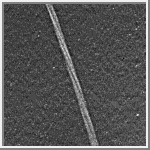 Twisted Rings
Twisted Rings
This portion of one of Neptune's rings appears to be twisted. Scientists believe it looks this way because the original material in the rings was in clumps that formed streaks as the material orbited Neptune. The motion of the spacecraft added to the twisted appearance by causing a slight smearing in the image. (Courtesy NASA/JPL)
The following table is a summary of the rings of Neptune.
| Name | Distance* | Width | Thickness | Mass | Albedo |
|---|---|---|---|---|---|
| 1989N3R | 41,900 km | 15 km | ? | ? | low |
| 1989N2R | 53,200 km | 15 km | ? | ? | low |
| 1989N4R | 53,200 km | 5,800 km | ? | ? | low |
| 1989N1R | 62,930 km | <> | ? | ? | low |
*The distance is measured from the planet center to the start of the ring.
The following table summarizes the radius, mass, distance from the planet center, discoverer and the date of discovery of each of the moons of Neptune:
| Moon | # | Radius (km) | Mass (kg) | Distance (km) | Discoverer | Date |
|---|---|---|---|---|---|---|
| Naiad | III | 29 | ? | 48,000 | Voyager 2 | 1989 |
| Thalassa | IV | 40 | ? | 50,000 | Voyager 2 | 1989 |
| Despina | V | 74 | ? | 52,500 | Voyager 2 | 1989 |
| Galatea | VI | 79 | ? | 62,000 | Voyager 2 | 1989 |
| Larissa | VII | 104x89 | ? | 73,600 | Voyager 2 | 1989 |
| Proteus | VIII | 200 | ? | 117,600 | Voyager 2 | 1989 |
| Triton | I | 1,350 | 2.14e+22 | 354,800 | W. Lassell | 1846 |
| Nereid | II | 170 | ? | 5,513,400 | G. Kuiper | 1949 |

 Return to Uranus
Return to Uranus  Voyage to Pluto
Voyage to Pluto
Resource : www.solarviews.com







Tidak ada komentar:
Posting Komentar